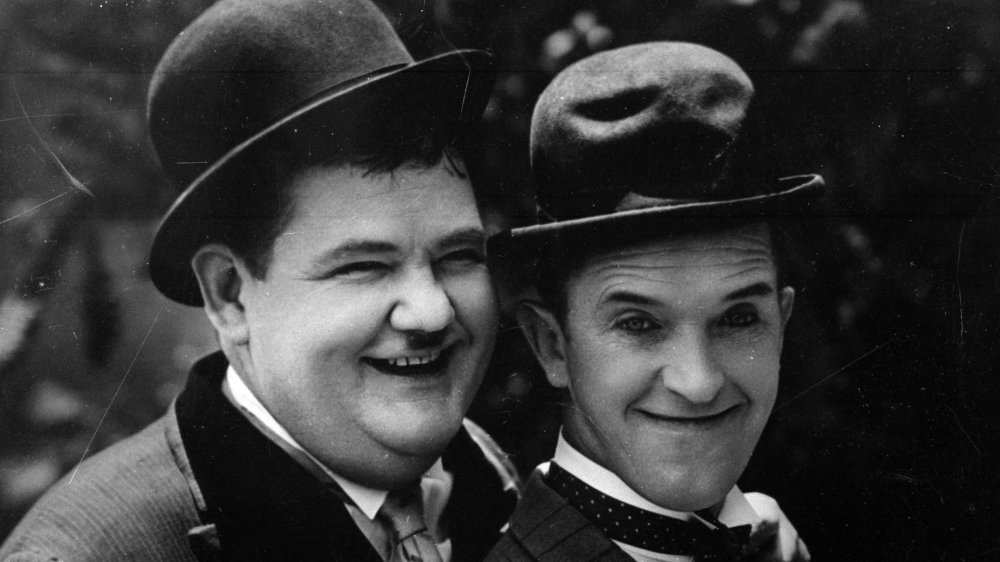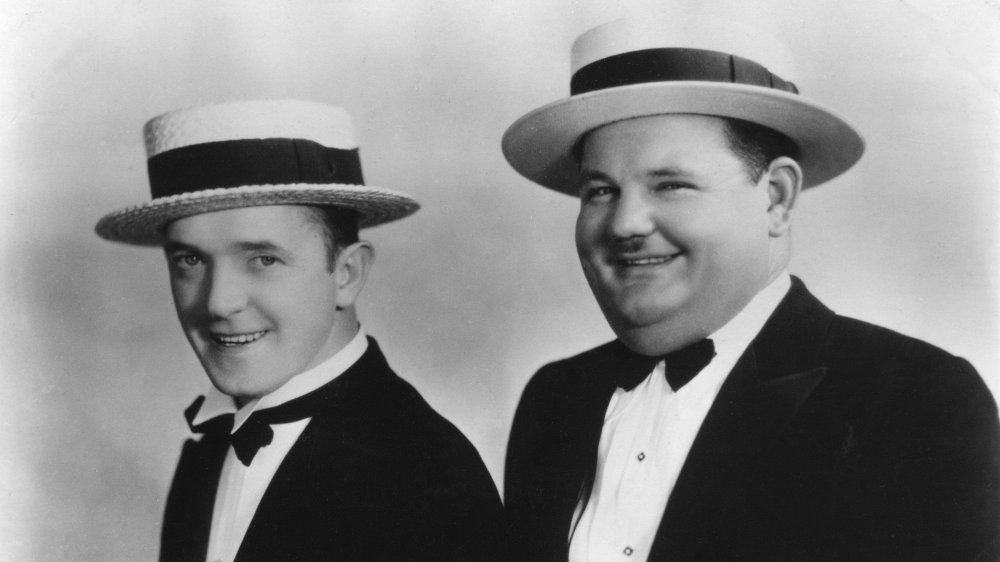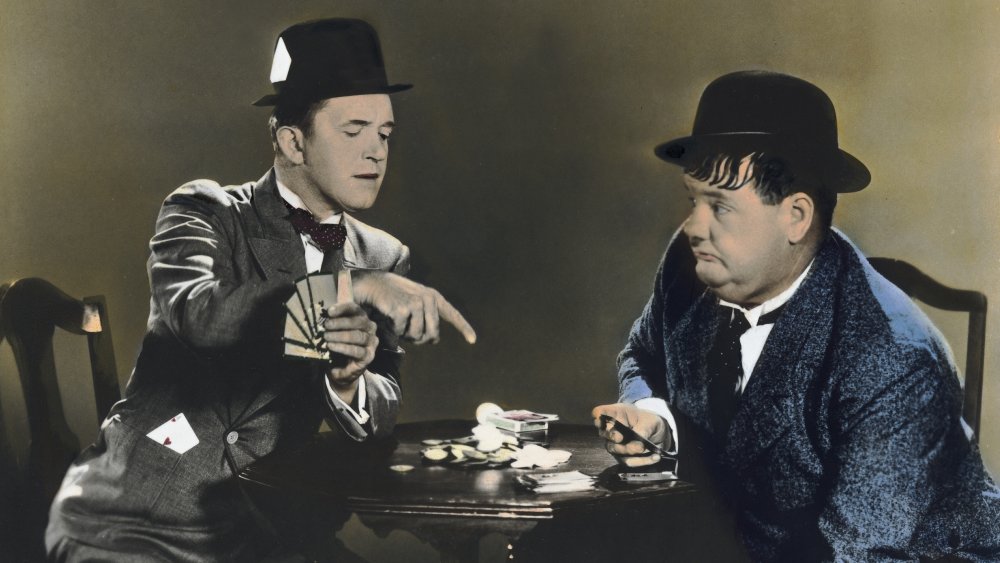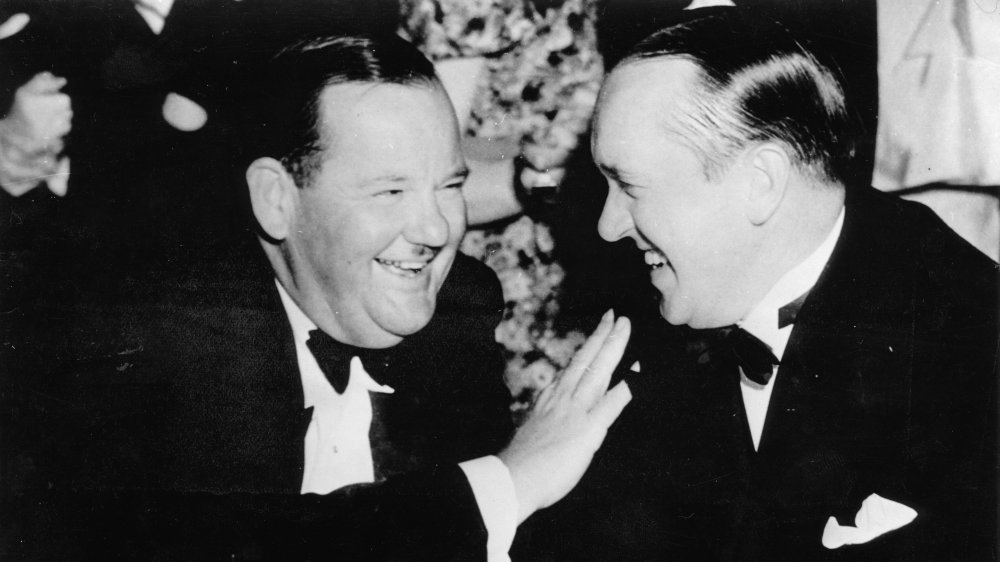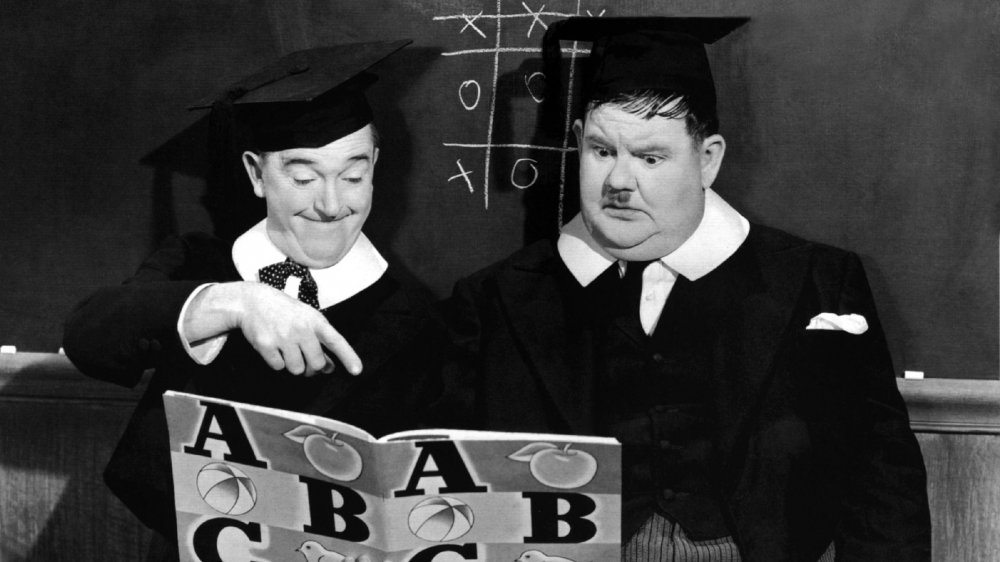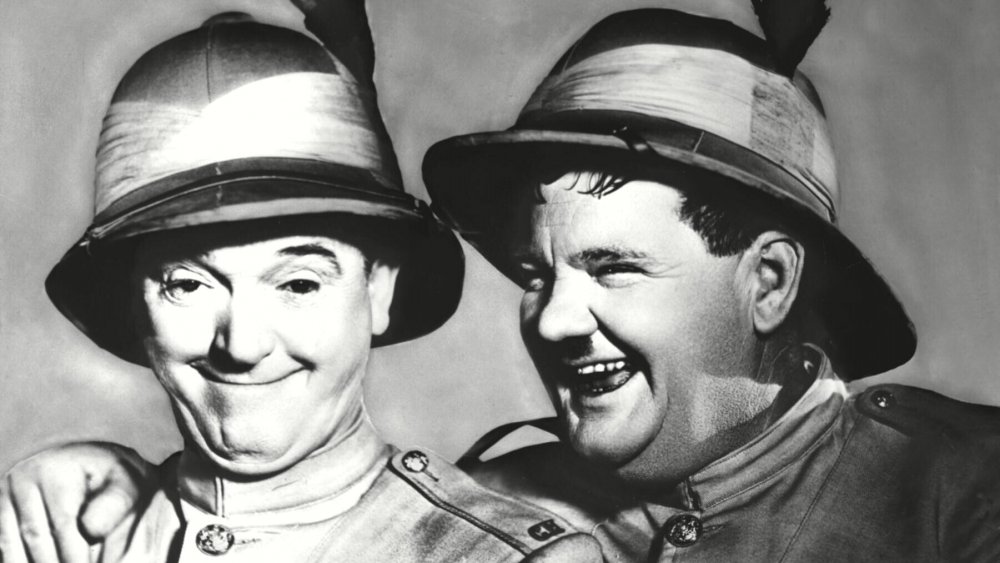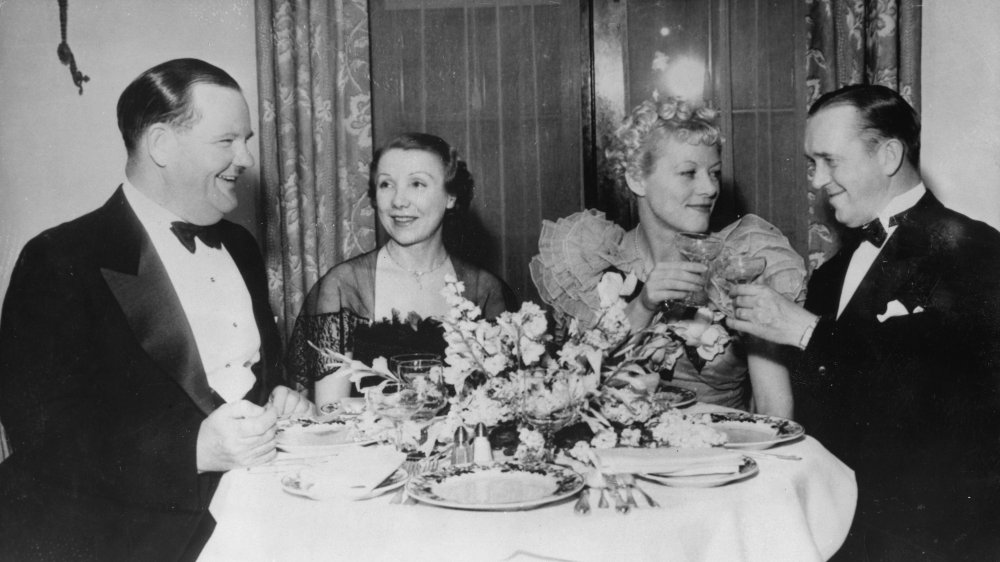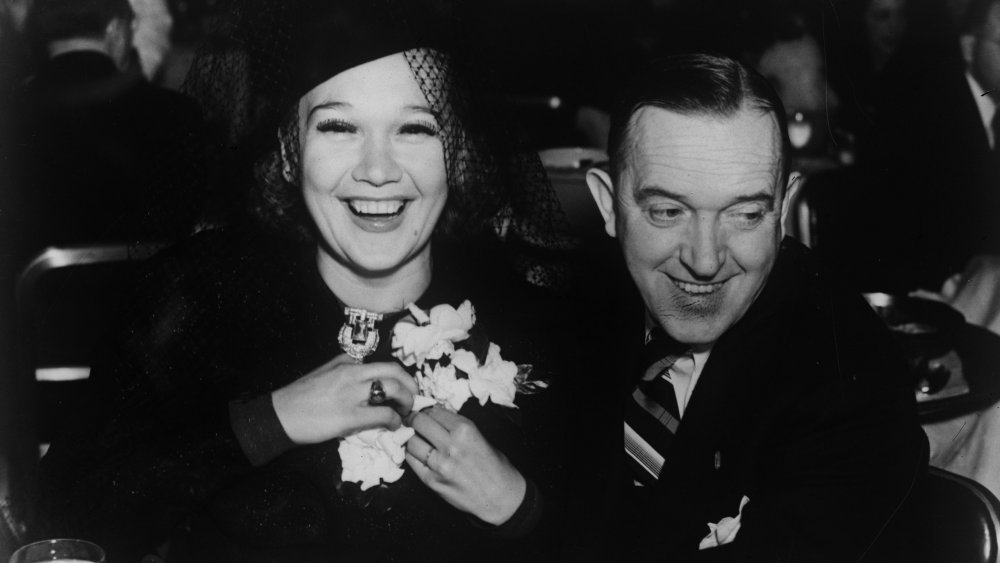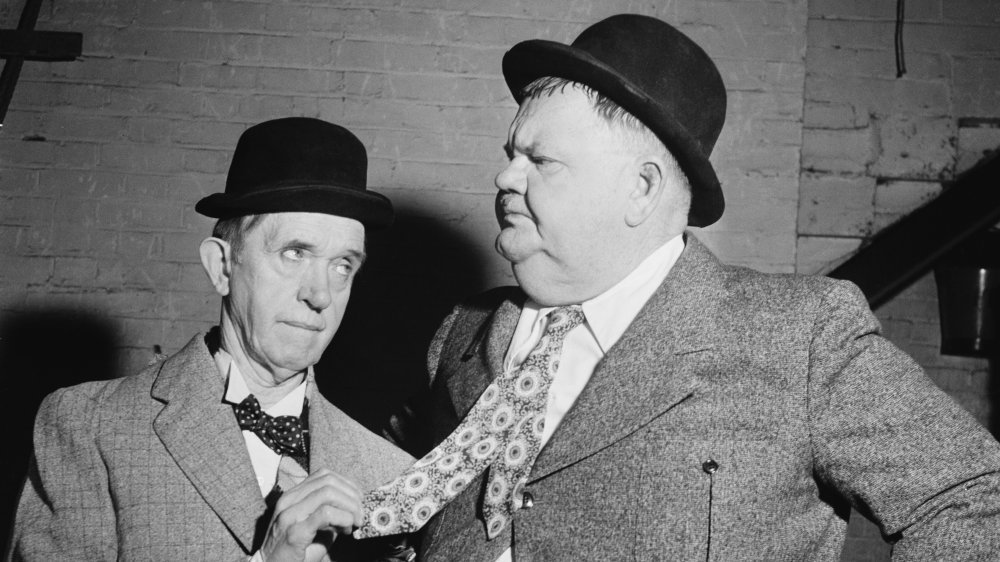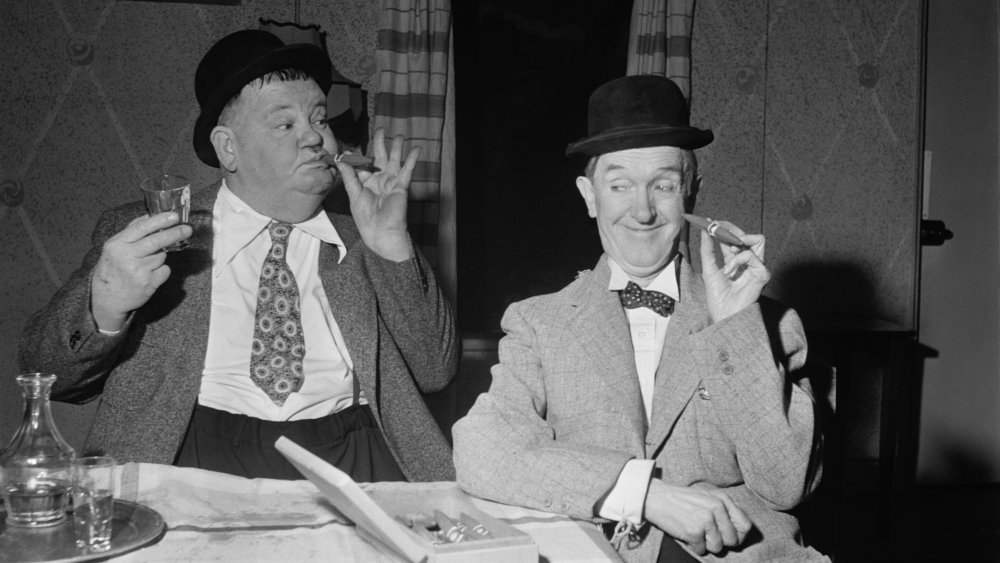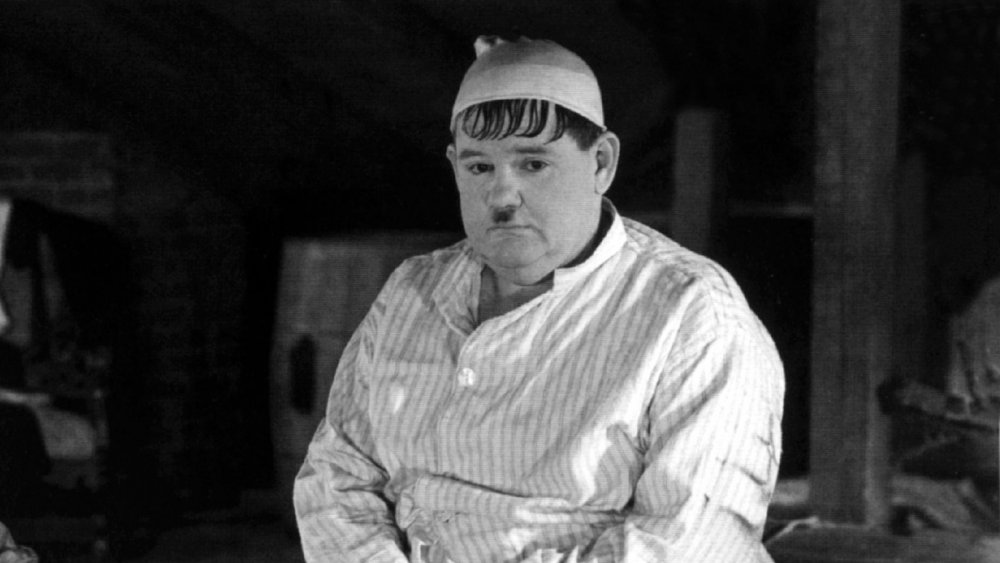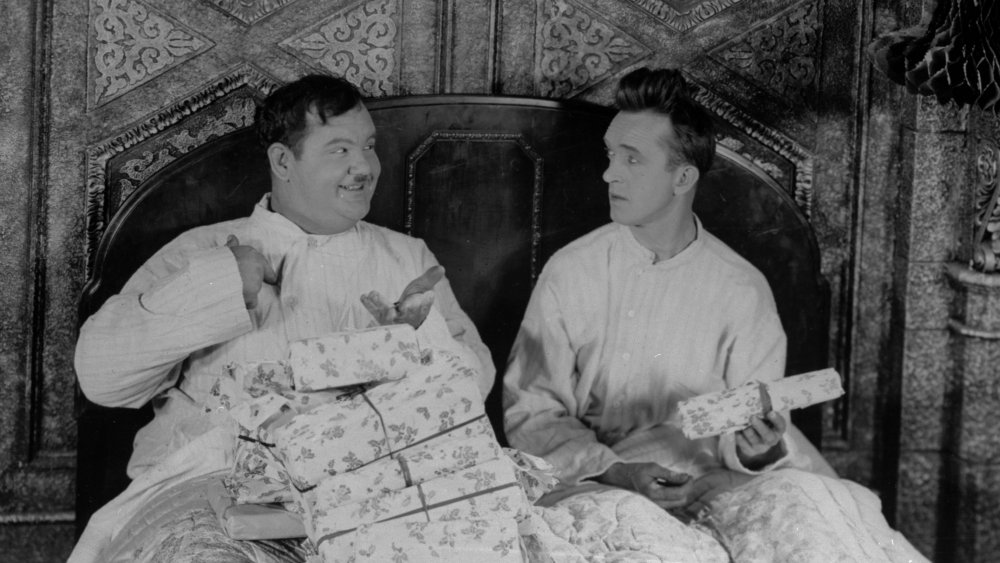Tragic Details About Laurel And Hardy
Eighty years after their heyday, Laurel and Hardy remain icons of comedy. Few performing acts successfully transitioned from the Silent Era into the age of sound, but Oliver Hardy and Stan Laurel used a combination of visual contrast — the rotund and imposing Hardy standing next to the thin, angular Laurel — peerless physical comedy, and sharp comic timing to become one of the most popular comedy acts of the 1930s.
Those comedy fundamentals have allowed the duo to endure in popular culture long after their death. After winning an Academy Award for Best Live Action Short Subject for 1931's The Music Box, the comedy team proceeded to make hit after hit during the 1930s, mostly working in short films of forty minutes or less. After changing film studios in the early 1940s, their popularity fell (along with the perceived quality of their films), but television kept them in the public eye and ensured their work would never be forgotten.
As is often the case with our funniest performers, however, the lives of Stan Laurel and Oliver Hardy were hardly free from tragedy and sorrow. In fact, as the tragic history of Laurel and Hardy will show, they might have had more than their fair share of both.
Oliver Hardy lost his father and brother
Norvell Hardy was born in Georgia in 1892. As noted by the encyclopedia Britannica, his father, Oliver Hardy, died just a few months after his birth. His mother supported the family by managing hotels and boarding houses. Sometime in his teenage years, Hardy began using the name Oliver in honor of his father.
That wasn't the only loss Hardy suffered during his childhood. As the Union Recorder reports, when he was 17 years old, his older brother Sam visited home, and the brothers decided to go swimming at an old mill dam on the Oconee River. Sam, showing off for his kid brother, climbed a tree and dived into the river from an overhanging branch. Tragically, he misjudged the depth of the water and broke his neck on the rocks below the surface.
Oliver Hardy and his friends dived into the river and pulled Sam out. They carried him back to the hotel their mother ran, but it was too late: Sam was dead. Decades later, when Hardy appeared on the television program "This Is Your Life," he became very emotional when the subject was brought up, showing how much of a mark the loss left on the young boy.
Stan Laurel lost his mom as a kid
Stan Laurel was born Arthur Stanley Jefferson in 1890 in England. While Laurel had a relatively happy family life, as author Raymond Valinoti Jr. notes, he was frequently alone as a child. His parents were performers and theater managers, and they frequently traveled. They took their children with them — except Stan, who was weak and "sickly" as a child. Laurel wound up spending much of his childhood with his grandparents, George and Sarah Metcalfe.
According to Valinoti, the Metcalfes were kind to Laurel, but they were very strict, and he spent much of his time alone in a shack on their property being punished for one thing or another. Still, Laurel grew into a performer just like his parents, and he quickly began writing his own plays and pursued theater. While this initially disappointed his parents, who hoped Laurel would come work with them, they supported his dreams.
Then, when Stan Laurel was just 18 years old, tragedy struck: His mother, Madge, unexpectedly died. It's suspected she suffered from a respiratory illness made worse by the air quality in Glasgow, where the family had relocated. Laurel, who had discovered his father was cheating on Madge some years before, blamed his father for breaking his mother's will to live. According to his second wife, Virginia Ruth Rogers, Laurel was absolutely devastated by the loss of his mother, and in some ways, never recovered from it.
Oliver Hardy was teased for being obese
Part of the magic that was Laurel and Hardy as a comedy act was their physical disparity. Stan Laurel's weepy, rail-thin figure next to Oliver Hardy's robust frame (he weighed more than 300 pounds for most of his life, per the Vintage News) was inherently charming to audiences. Hardy's weight was part of his identity, and also the cause of his health problems later in life.
Hardy's weight also caused him grief in his younger days. As reported by Lake Oconee Living, Hardy was known as "Fatty" Hardy throughout his childhood — even after he became a famous Hollywood star, locals in his hometown in Georgia referred to him as "Fatty." His mother, who managed local boarding houses, made things even worse when she made young Hardy walk around town wearing a sandwich board advertising the food at her hotels.
His size continued to plague him as he got older. When America entered World War I, Oliver Hardy sought to do his patriotic duty and went to a local enlistment office to join the army. According to author Raymond Valinoti, Jr., the officers took one look at Hardy's size and began to make fun of him, calling other recruiters over to look at him. He left humiliated.
Laurel and Hardy were bad with money
Laurel and Hardy, the iconic comedy duo, wouldn't exist without Hollywood producer Hal Roach. Both Oliver Hardy and Stan Laurel were working actors during the 1920s, but neither had achieved any sort of breakout success. Roach saw their potential and put them together in 1927's The Second Hundred Years.
From that point on, the pair rose to stardom under Roach's guidance — but Roach was a sharp businessman, and Laurel and Hardy were ... not. According to Smithsonian Magazine, Roach managed to keep the upper hand through shrewd negotiating. For example, he staggered the expiration dates of their contracts so they could never negotiate as a team, which allowed Roach to consistently undervalue them. He paid them a flat wage instead of a percentage of the profits. Roach also ensured that they never held any of the copyrights, or got any screenwriting credits, although they usually took a very active role in the writing and directing of their films.
As both men went through several divorces, alimony payments piled up, and Oliver Hardy developed a gambling problem. By the 1950s, Laurel and Hardy had to embark on a live tour of English music halls to try to pay some bills — which failed when Hardy took ill and the tour had to be canceled. Oliver Hardy died surprisingly broke, and New Statesman reveals that in 1946, Stan Laurel was forced to admit he only had $2,000 in his bank account — and $200 a month to live on.
Their career declined in the 1940s
For about 14 years, Laurel and Hardy were one of the most popular comedy duos in Hollywood. They often took an active role in shaping the films they worked on, writing and introducing physical gags. As the Los Angeles Times reports, they usually improvised much of their bits, and carefully planned and even directed scenes while working with producer Hal Roach.
But as Smithsonian Magazine notes, Roach was a hard negotiator who made sure Laurel and Hardy didn't own the rights to their work, making certain they had to negotiate their deals separately. When they finally had the chance to break away, they leaped at it, signing new deals with 20th Century Fox and Metro-Goldwyn Mayer in 1941.
But as The Chicago Tribune notes, with Roach, Laurel and Hardy had enjoyed a great deal of creative control. When they moved to MGM in the 1940s, they were disappointed to find they'd lost that — they were treated as hired actors, with no input on the scripts or direction. As a result, their output in the 1940s is considered to be of lower quality, and their stars began to fade. In 1945, they were dispirited enough to retire, returning briefly to make what most regard as their worst film, Atoll K, in 1951, per the New Georgia Encyclopedia. By 1953, they were broke and out of the film business.
Oliver Hardy was unlucky in love
Oliver Hardy married Madelyn Saloshin in 1913 when he was just 21 years. The couple eloped to Macon, Georgia for the nuptials, claiming that since they were both a part of touring troupes of actors and musicians, they couldn't wait until they were both home to hold a ceremony. The Hardy family reported that Hardy's mother was enraged at the union because Saloshin was older than her son.
But as author Simon Louvish writes, the reason for the Hardy family's opposition to the marriage was likely much worse: Saloshin was Jewish. Hardy married her far away from his family to avoid an ugly scene, and the couple left Georgia almost immediately.
The marriage lasted six years, and Hardy would describe it as a "sham" in his divorce application. He married Myrtle Reeves shortly after the divorce was granted, but once again marital bliss was denied him. As Louvish notes, Reeves was an alcoholic who was forced to stay in a sanitarium several times as she struggled with her disease, leaving Hardy desperate to leave the marriage.
He finally found contentment after divorcing Reeves in 1940. He married Virginia Lucille Jones, who remained by his side until his death in 1957.
Stan Laurel was unlucky in love
Stories of Hollywood stars piling up marriages and divorces are common enough, but Stan Laurel stands out. He was married no fewer than six times — and even married one of his ex-wives twice.
According to New Statesman, first came Mae Dahlberg, an older woman from Australia he met in 1917; she was considered to be Laurel's common-law wife. Dahlberg was difficult, and according to writer Simon Louvish, producer Joe Rock paid Dahlberg off to return to Australia. She returned years later to sue Laurel for financial support, and per the Los Angeles Times, agreed as part of the settlement that they had never been married.
Laurel was happy to see Dahlberg go because he wanted to marry Lois Neilson. But he almost immediately cheated on Neilson, and they divorced eight years later. Laurel quickly married Virginia Ruth Rogers, but just two years into the marriage, he told her that he still had feelings for Neilson. They divorced in 1937. Neilson rejected Laurel (maybe he should have checked with her before filing for divorce), but Laurel didn't let that get him down — he married Vera Ivanova Shuvalova in 1938.
Shuvalova drank heavily and accused Laurel of bizarre abuse, including an attempt to bury her alive. When he divorced her, he actually married Rogers again, with this second attempt lasting five years.
Laurel finally found love with Ida Kitaeva Raphael, who he married in 1946 and remained with until his death in 1965.
Stan Laurel retired when Hardy died
Oliver Hardy and Stan Laurel were unique Hollywood comedians in many ways. One of the most surprising was the fact that they were very close friends in real life. As The Vintage News reports, they enjoyed a very healthy and balanced professional relationship, wherein Hardy trusted Laurel to shape the material in their films and went along with his ideas. This mutual respect extended to their career dealings as well. Producer Hal Roach forced them to negotiate their contracts separately in order to control how much he paid them. When they finally got out from under Roach's control in the early 1940s, neither considered working alone.
Author Simon Louvish reports that their friendship was so close, in fact, that when Hardy became reclusive towards the end of his life, Laurel was part of a very small number of people who visited him regularly. Hardy, concerned for his health, had lost more than 150 pounds and was sensitive about his appearance — but the crash diet was too late; he suffered a massive stroke in 1957 and died. Stan Laurel was crushed and chose to retire from show business rather than work without his friend of more than 30 years.
Their final film was a disaster
The final phase of Laurel and Hardy's film career was a lengthy decline. When they switched film studios in the 1940s and lost creative control over their work, their quality declined and public tastes shifted, leaving them less popular than they'd once been. They were virtually retired by 1945.
According to Norbert Aping, after World War II ended, Laurel and Hardy's celebrity suddenly took off internationally as their films were finally widely distributed, and so it was decided that there was potential to relaunch their film careers with a French-Italian co-production that eventually became known as Atoll K.
The production was a fiasco. There were language barriers and a terrible script to contend with — but the truly tragic aspect was Laurel and Hardy's health. Hardy was at his heaviest, and suffered heart problems as well as a serious bout of the flu, while Stan Laurel was dealing with his diabetes and a prostate condition. The Sunday Post reports that both men were considered heavy smokers in an era when smoking was common and accepted, which didn't help their conditions. As Aping notes, when production had to be halted for the actors to recover, the result is scenes where Stan Laurel appears to age a decade in a matter of seconds. In a final humiliation, the producers found it impossible to get the film into theaters. In the end, the final film of Laurel and Hardy was a sad end to their brilliant careers.
Oliver Hardy's final years were hard
Oliver Hardy was a big man his whole life. In fact, as Lake Oconee Living reports, he was known as 'Fatty' as a little kid, and when he grew up and launched his entertainment career he was initially known as 'Babe Hardy' due to his size, which was usually well over 300 pounds.
His weight caused him many health concerns over the course of his life, and by the 1950s he finally decided to do something about it. As author Raymond Valinoti, Jr., notes, he embarked on a crash diet that led to a weight loss of 150 pounds. Hardy expected people to be supportive, but as author Simon Louvish says, the change in Hardy's appearance was so drastic that friends and family were visibly upset at the sight of him. This bothered Hardy terribly, and he went into near-seclusion, seeing only a short list of trusted friends — including Stan Laurel.
Then, in September 1956, Oliver Hardy suffered a massive stroke that left him paralyzed and mute. He was unable to concentrate on anything or communicate effectively with the people around him. When he became especially agitated or depressed, his wife would invite Stan to visit. He lingered on for almost a year, being diagnosed with cancer and suffering an additional two strokes, and died in August 1957.
Stan Laurel was lonely and frequently ill
By the 1950s, Stan Laurel had been struggling with his own health. Laurel had chronic problems with his prostate, and per author Norbert Aping, he had to have an ulcer surgically removed from his prostate. He was also a diabetic, and the disease complicated his health. According to The Los Angeles Times, Laurel had a stroke in 1955 — which he survived, but it left him weak.
When Oliver Hardy died in 1957, instead of pursuing solo work, Laurel quietly retired. He was uninterested in working with anyone but his longtime friend. He moved into a small apartment in Santa Monica with his wife, Ida.
As New Statesman reports, Laurel spent his final years as a lonely man who spent his time writing letters — possibly thousands of them. Laurel spent hours every day corresponding with anyone he could, faithfully answering fan letters and sending missives off to his acquaintances. Some of these letters reveal tragic facts, as when he writes that after his stroke "of course I shall never be in a condition to work any more." Some are heartbreaking in their lack of necessity. One written in 1964 reads in its entirety "Just a few more stamps — hope you're feeling well — nothing much to tell you, everything is as usual here."
Even more tragic, Stan Laurel penned something other than letters during his final years. He also wrote comedy routines designed for Laurel and Hardy — routines that would never be performed. As New Statesman notes, it was almost as if it was Laurel's way of staying in touch with Hardy.
